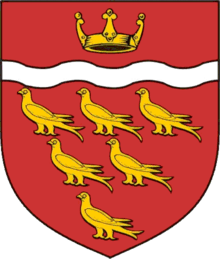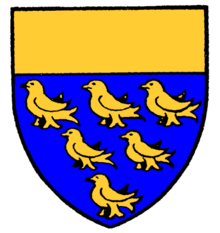Coat of arms of Sussex
A heraldic shield (often erroneously referred to as a coat of arms) has been associated with the historic county of Sussex since the seventeenth century. The device, displaying six martlets or heraldic swallows on a shield, later formed the basis of the flag of Sussex and the armorial bearings granted to the county councils of East and West Sussex.
Although often referred to as a coat of arms, the six gold martlets on a blue shield is not an official Coat of Arms and is more of an Emblem, very much the same as the Yorkshire Rose.[1] Under English Heraldic law a Coat of Arms can not be granted to a county, but only the administrative body.[1] As Sussex hasn't had a single administrative body since 1086, the year of the Domesday Book, the device is an emblem.[1]
History

The earliest recorded use of the device appears to be in the atlas Theatrum Imperii Maganae Britanniae produced by John Speed in 1622. The book displays arms for each of the seven kingdoms of the Anglo-Saxon heptarchy, and that shown for the Kingdom of the South Saxons was six golden martlets on both a blue (azure) or red (gules) shield. In both cases the device were ensigned by an ancient crown. It is possible that the device had a much earlier origin, as arms were attributed to other Saxon kingdoms by the heralds in the later Middle Ages. These attributed devices were a prochronism, as heraldry did not develop until some centuries after the existence of the kingdoms. The arms later used by local authorities in Essex, Middlesex, Kent, Northumberland and County Durham all owe their origins to the medieval heralds.[2]
By the nineteenth century the blue shield bearing gold martlets had become accepted as an emblem of the county of Sussex. The seal of the clerk of the peace of the county bore the arms, as did the badges of the East Sussex Constabulary and the Sussex Yeomanry.[3][4]
County councils
The Local Government Act 1888 introduced administrative counties each governed by an elected county council. Sussex was divided into two administrative counties: With the exception of the county boroughs of Brighton, Hastings and from 1911, Eastbourne, East Sussex County Council administered the rapes of Lewes, Pevensey and Hastings, while West Sussex County Council administered the rapes of Chichester, Arundel and Bramber. Each county council was required to adopt a common seal.
The Local Government Act 1972 reorganised councils throughout England and Wales from 1974. In Sussex two new non-metropolitan counties of East Sussex and West Sussex were created, but with different boundaries to the administrative counties abolished by the 1972 Act. Accordingly, the two county councils had to apply for new arms. Both county councils were granted arms in 1975, based on those previously used.
East Sussex


East Sussex County Council adopted a seal in 1889. The seal bore a quartered shield. The first quarter represents Sussex, while the second, third and fourth quarters each represent one of the traditional Sussex subdivisions, known as rapes, administered by East Sussex County Council at the time.
- The first quarter bore the traditional six gold martlets on blue of Sussex
- The second quarter consisted of gold and blue checks from the arms of the De Warenne family, Earls of Surrey and lords of the barony of Lewes
- The third quarter was gold with a red displayed eagle, arms of the De Aquila family, lords of the rape of Pevensey
- Representing the rape of Hastings, the fourth quarter bore the arms of Hastings
These unofficial arms remained in use until 1937 when a grant of arms from the College of Arms was obtained on 10 September. A red shield was adopted and a gold Saxon crown was added for heraldic difference. The arms were blazoned as: Gules, six martlets three, two and one, and in chief a Saxon crown or[5]
East Sussex County Council was granted a new coat of arms on 29 August 1975. The arms are identical to the 1937 grant with the addition of a silver wavy line, representative of the coastal county boroughs of Brighton, Eastbourne and Hastings added to the county in 1974.[6]
West Sussex

West Sussex County Council promptly applied to the College of Arms for a grant of arms, which were granted on 18 May 1889.[7] The cost of the grant was met by the Duke of Norfolk, a member of the council and titular head of the College of Arms. West Sussex was the first county council to become armigerous.
The arms were the same as those associated with the historic county with the addition of a gold "chief" or band at the top of the shield. The blazon or technical description was: Azure, six martlets, three, two and one a chief or.[8]
West Sussex County Council was granted new arms on 14 January 1975. The gold chief of the 1889 shield was modified by being given an "indented" edge. A crest was added, shown atop a helm and decorative mantling. The crest represented the areas transferred from East Sussex and Surrey in 1974: the Saxon crown was taken from the East Sussex arms and the acorns from those of Surrey.[9]
The blazon of the arms is: Azure six martlets three two and one and a chief indented or, and for a crest on a wreath of the colours a sprig of oak proper fructed with two acorns or within a Saxon crown also or.[10]
Other organisations

The Sussex Police Authority was granted arms on 30 May 1969: a blue shield bearing a gold tower between five gold martlets.[5]
The Sussex County Cricket Club uses the traditional county arms as its badge.
The Sussex Motor Yacht Club, founded in 1907 and headquartered in Brighton, uses the traditional Sussex county arms (i.e., the six martlets) on its club burgee; it depicts the martlets in red, and places them on a white shield, surmounting a three-bladed propeller, which also in red.
See also
References
- 1 2 3 "Sussex Emblem". Retrieved 20 April 2012.
- ↑ Charles Wilfrid Scott-Giles, The Romance of Heraldry, London, 1929
- ↑ Francis W Steer, The arms of the County Councils of East and West Sussex and the Diocese of Chichester, jointly issued by the two county councils, 1959
- ↑ A L King and H L Kipling, Head-dress badges of the British Army, Volume 1, reprinted Uckfield 2006
- 1 2 Geoffrey Briggs, Civic and Corporate Heraldry, London, 1971
- ↑ Letters Patent dated 29 August 1975
- ↑ Letters Patent sealed by Garter, Clarenceux and Norroy Kings of Arms.
- ↑ Arthur Charles Fox-Davies, The Book of Public Arms, 2nd edition, London 1915
- ↑ West Sussex County Council Archive Gallery, accessed 24 August 2007
- ↑ Civic Heraldry of England and Wales - West Sussex, accessed 24 August 2007